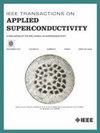Numerical Investigation on Current Behaviors of NI Multi-Tape-Bundled REBCO Coils Wound With Dump Resistance for Sudden Discharge Test
IF 1.7
3区 物理与天体物理
Q3 ENGINEERING, ELECTRICAL & ELECTRONIC
引用次数: 0
Abstract
Progress in the field of applied superconductivity, such as MRI, NMR, and compact fusion reactors, relies on improvements in material developments and winding techniques. The no-insulation (NI) winding technique enables rare-earth barium copper oxide (REBCO) coils to show high electromagnetic characteristics, while having a high current density. The multi-tape-bundled winding technique improves charging delays on large-scale NI REBCO coils. Meanwhile, previous research has suggested several disadvantages of these techniques. Especially in the NI multi-tape-bundled REBCO coils, rapid discharging is reported due to the influence of a small coil inductance, which makes coil protection harder. In this paper, several D-shaped multi-tape-bundled REBCO coils with dump resistor are modeled. Sudden discharging tests are simulated for each model with a different number of bundled tapes and turn-to-turn contact resistivities. The simulation results show that REBCO-tape-longitudinal currents are concentrated on one side, meanwhile the opposite-directional currents are observed on the other side. The concentration is larger as the number of bundled tapes increases. In addition, the Joule heat simulation shows that the energy stored in a coil is discharged faster on the more-tapes-bundled NI REBCO coil, although the energy extracted into the dump resistor is smaller due to the low turn-to-turn/tape-to-tape contact resistance. Further investigations will be needed, especially for a thermal simulation.突然放电试验中NI多带捆扎式REBCO线圈电流行为的数值研究
应用超导领域的进展,如核磁共振、核磁共振和紧凑型聚变反应堆,依赖于材料发展和缠绕技术的改进。无绝缘(NI)绕组技术使稀土钡氧化铜(REBCO)线圈具有高电磁特性,同时具有高电流密度。多带捆扎绕组技术改善了大型NI REBCO线圈的充电延迟。同时,先前的研究也指出了这些技术的几个缺点。特别是在NI多带捆扎的REBCO线圈中,由于线圈电感较小的影响,导致快速放电,这使得线圈保护更加困难。本文对几种带自卸式电阻器的d形多带捆扎式REBCO线圈进行了建模。用不同数量的捆扎带和匝间接触电阻率对每个型号的突然放电试验进行了模拟。仿真结果表明,rebco -tape纵向电流集中在一侧,而另一侧则存在相反方向的电流。浓度随捆扎胶带数量的增加而增大。此外,焦耳热模拟表明,存储在线圈中的能量在更多磁带捆绑的NI REBCO线圈上释放得更快,尽管由于低匝对匝/磁带对磁带的接触电阻,提取到转储电阻的能量更小。需要进一步的研究,特别是热模拟。
本文章由计算机程序翻译,如有差异,请以英文原文为准。
求助全文
约1分钟内获得全文
求助全文
来源期刊

IEEE Transactions on Applied Superconductivity
工程技术-工程:电子与电气
CiteScore
3.50
自引率
33.30%
发文量
650
审稿时长
2.3 months
期刊介绍:
IEEE Transactions on Applied Superconductivity (TAS) contains articles on the applications of superconductivity and other relevant technology. Electronic applications include analog and digital circuits employing thin films and active devices such as Josephson junctions. Large scale applications include magnets for power applications such as motors and generators, for magnetic resonance, for accelerators, and cable applications such as power transmission.
 求助内容:
求助内容: 应助结果提醒方式:
应助结果提醒方式:


